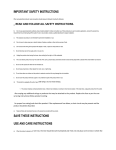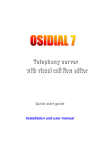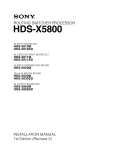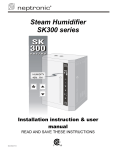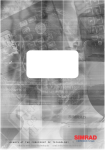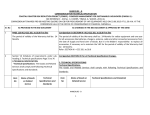Download SP3300 VHF Portable GMDSS
Transcript
SAILOR SP3300 Operation Manual Introduction The SAILOR Portable VHF SP3300 is approved to fulfil the GMDSS requirements for portable VHF radios for Safety at Sea and is waterproof to IP67 standard. As part of the required safety equipment, the SAILOR SP3300 is to be used in an emergency situation. However, the best way to guarantee functionality in an emergency, is to use the radio in the daily communication onboard. This is possible due to a unique battery concept. The primary emergency battery is to be stored for emergency situations and a secondary rechargeable battery can be used for daily communication. In this way you have at least 8 hours operation time. The range of maritime communication products from SAILOR includes radios for the leisure market to equipment for fishing vessels and complete communication solutions for the deep sea sector. Everything is covered from basic VHF units to state-ofthe-art satellite systems, Ship Security Alert Systems and complete compact GMDSS solutions. Please find your nearest SAILOR distributor on: www.sailor.dk SAILOR operate a policy of continual development and reserve the right to alter and improve the specification of our products without notice. Thank you for choosing SAILOR. Please note Any responsibility or liability for loss or damage in connection with the use of this product and the accompanying documentation is disclaimed. The information in this manual is furnished for informational use only, is subject to change without notice, may contain errors or inaccuracies, and represents no commitment whatsoever. This agreement is governed by the laws of Denmark. Doc. no.: B3300GB0 ii Issue: C/0451 Contents Introduction ............................................................................................................. ii Warranty Limitation .............................................................................................................. 1 Operation ................................................................................................................. 2 Controls ................................................................................................................................ 2 Disable/Enable Key Beep .................................................................................................... 4 Keypad Lock ......................................................................................................................... 5 Removing and Attaching Battery ......................................................................................... 5 Charger Options ................................................................................................................... 5 Charging of Batteries ........................................................................................................... 6 Battery Level Indicator ......................................................................................................... 6 General .................................................................................................................... 7 Antenna ................................................................................................................................ 7 Transmission Range ............................................................................................................ 7 Frequency of Channels ........................................................................................................ 8 Battery Life Guidelines ........................................................................................................ 9 Fault Finding ...................................................................................................................... 10 Technical Specification ...................................................................................................... 11 Spare Parts & Accessories ................................................................................... iii Warranty Limitation IMPORTANT - The radio is a sealed waterproof unit. To create and maintain its waterproof integrity it was assembled in a controlled environment using special equipment. The radio is not a user maintainable unit, and UNDER NO CIRCUMSTANCES should the unit be opened, except by authorised personnel. Unauthorised opening of the unit will invalidate the warranty. 0438 1 Operation Controls 1 The location of the controls for the radio 1 2 3 4 5 6 7 8 9 10 11 2 Function 3 On/off High/Low power / Keypad Lock PTT (Push To Talk) Volume mode select Squelch mode select Up key Down key Scan mode Dual /Tri watch Select Priority / Personal channel Backlight on/off & Light Mode select 4 5 6 7 8 9 10 11 Pressing and holding certain keys will access additional functions. These are indicated by a double beep, or a triple beep if held for longer (see table below). Key 1 x Press 2 x Press VOL Select Volume Mode * Select secondary SQ Select Squelch Mode Standard Mode Channel Up / Down Volume Mode Volume Up / Down Squelch Mode Squelch Up / Down Light Mode Light level Up / Down Disable / Enable First Key Beep SCAN Memory Scan D/W Dual Watch 16 Select Channel 16 Press & Hold Double Beep Press & Hold Triple Beep Hold During Power Up channel set Add / Delete Inhibit / Enable channel from Scan All Channels selected channel memory scan from scan Tri Watch Select Personal Set Personal Channel Channel Select Light Mode Backlight On/Off Hi/Lo Select 1 or 2.5 Watt Engage / disable keypad lock * If available 2 0451 On/Off (1) Press to turn the radio on. To turn off, press and hold the key for approximately 2 seconds. This is to avoid accidental power off. Hi/Lo (2) Toggles between high and low transmit power (see specification section). Use the low setting over short ranges to preserve battery life. VOL - Volume (4) SQ - Squelch (5) Press to select Volume or Squelch mode then use the and keys to adjust the level. The display will show “VOL” or “SQL” for 3 seconds - if / are not pressed within this time, their function will revert to channel select. / (6 & 7) These keys will change the selected channel. Pressing VOL, SQ or , then / within 3 seconds will adjust the volume, squelch or backlighting level respectively. The bargraph will indicate the level selected. SCAN mode (8) Scans through the channels stored in the channel memory (display shows MEM SCAN). 0438 • Select channel and press twice to add/ delete to memory scan (display shows ENT or DEL respectively). The ❑ icon indicates that the selected channel is included in memory scan. • Press and hold until double beep sounds to scan all channels (display shows SCAN). • Press and hold until triple beep sounds to inhibit/enable selected channel from scan (display shows INH or ENA respectively). The - icon indicates the selected channel is inhibited a b f c g d h e i a. Bar graph Power up Battery level Standby Battery level Transmit Battery level Volume Mode Volume level Squelch Mode Squelch level pressed Backlight level b Personal Channel indicator c Channel selected e High or Low power indicator f Function indicator g Selected channel stored in momory h Channel inhibited from scan i Scan mode selected 3 D/W - Dual Watch / Triwatch (9) Press to select Dual Watch of selected channel and Ch16. Display shows D/W. • Press and hold until double beep sounds for Triwatch - selected channel, personal channel and Ch16. Display shows T/W. 16 - Channel 16 / Personal Channel (10) Press to select channel 16. • Press and hold until double beep to select personal channel (display shows ) • Press and hold for three beeps to set selected channel as the personal channel. - Backlight (11) Press to turn on and off. Use / to adjust the backlighting level (5 levels available). The bargraph indicates the backlighting level selected. • Keep VOL held down The battery save function turns off the backlighting if no key is pressed after 20 seconds. Press any key (except or ) to turn light on again. Disable/Enable Key Beep The radio beeps every time a key is pressed to confirm operation. To disable key beep, press and hold SQ while turning the set on. Repeat this procedure to turn the key beep on again. • 4 Second level functions (such as All Channel Scan, Triwatch etc.) will still be indicated by a beep, even if the key beep is disabled. 0438 Keypad Lock The radio keypad can be locked to prevent accidentally pressing keys while in a pocket etc. To lock the keypad, press and hold the Hi/ Lo key. The radio will beep twice and any key pressed will not function - LOCK will appear in the display. To disengage keypad lock, press and hold Hi/Lo again. Note that the PTT key will still function when the keypad lock is on, allowing transmission and receiving as normal. Removing and Attaching Battery Battery pack removal The radio has two battery options - an 850mAh NiCa or a non rechargeable Lithium battery that is capable of providing sufficient power for the specified 8 hours according to regulations. To remove the battery, lift the two locking clips holding the battery pack in place. When reattaching, ensure the three locating pegs on the top of the battery are located into the slots in the radio and that the two locking clips have both engaged. The set is fully waterproof even with the battery removed, but it is recommended that any moisture on the top of the battery or in the battery compartment is wiped clear before attaching to prevent the water creating a conductive path between the contacts and reducing battery life. Charger Options Battery charger 0451 The radio can be supplied with a 12V standard charger that will accept the whole radio, or the battery alone. The standard charger runs from a standard 12V supply (10.5V-16V), or from AC mains with an appropriate optional adapter / power supply. Charging with the standard charger takes approximately 14-16 hours. There is also a fast charger available which will charge the battery within 1 1/2 hours. 5 Charging of Batteries To charge the NiCa battery pack, insert the battery or radio into the charger ensuring that excess moisture is wiped clear from the contacts on the back of the battery pack. The standard charger will trickle charge the battery to full capacity. The fast charger will rapid charge the battery until it is fully charged and will then automatically switch to maintenance charge. • Batteries are supplied uncharged. • Fully charge the battery when not in use, although it may lose some of its charge after several months of storage. • Do not charge at temperatures below 0°C or above 40°C. • Turn off radio if charging battery while fitted. • Regularly discharge the battery completely - repeated recharging of the battery while it is partly discharged may create a ‘memory effect’, preventing the battery reaching full charge. • Dispose of used batteries carefully. The contents of the batteries could be harmful to the environment. • Never expose to a naked flame. • IMPORTANT: The Lithium battery is not rechargeable, and under no circumstances should any attempt be made to recharge it. Replacement lithium batteries can be re-ordered from your local reseller. Charging options Battery Level Indicator Except when adjusting the Volume or Squelch, the bar graph on the display shows the battery charge level. This indicates the voltage at the battery terminals, not necessarily the charge stored. Ten or nine bars indicate a fully charged battery, three or four bars mean the battery is almost drained. 6 Battery level indicator • When using a lithium battery pack, the low level battery indicator may flash under transmit conditions. This does not necessarily reflect the charge level remaining in the battery, as it is due to the different voltage characteristics of a Lithium battery pack under load. 0438 General Antenna Transmission Range The antenna for the radio is fitted to the unit via a robust screw fitting to an M6 threaded socket on the top of the radio. This system is more rugged than a traditional BNC connector, so the radio’s drop-proof integrity is not compromised by the antenna fixing. Because VHF signals travel in a straight line and are not reflected back off the ionosphere as lower frequency signals are, the range of VHF signals is limited to ‘line of sight’, beyond which the other vessel passes behind the curve of the Earth. Therefore, the range will increase greatly the higher above sea level the antenna is, as illustrated (assuming maximum transmission power is used): While the radio is drop-proof and very robust, damage to the antenna such as bending or kinking may adversely affect the transmission efficiency of the unit, which may lead to overloading of the power module. Damaged antenna should be replaced immediately. Cherbourg Isle of Wight 87 km / 65 M 3M 6M 9-3 /2 2-1 m k -53 20 -26 km /1 46 30 m/ 100 ft Mast 20 km / 12 M 9 m/ 30 ft Mast 13 8- -16 10 km M Niton 8 km / 5 M Endeavour Replacement antenna and other spare parts can be purchased from your local reseller. Please refer to section Spare Parts & Accessories. 0438 Therefore, the typical range of a hand-held radio such as this one used at sea level will be approximately 8 Km (5 Miles). This will increase as height above sea level increases, or if the other radio user’s antenna is at a greater height - note that the range between the yacht with the antenna mounted on a 9 M (30 Ft) mast and the hand-held user increases to 13-16 Km (8-10 Miles). 7 Frequency of Channels Channel Designator 6 8 9 10 11 12 13 14 15 16 17 67 68 69 70 71 72 73 74 77 Tx 156.300 156.400 156.450 156.500 156.550 156.600 156.650 156.700 156.750 156.800 156.850 156.375 156.425 156.475 156.525 156.575 156.625 156.675 156.725 156.875 Rx 156.300 156.400 156.450 156.500 156.550 156.600 156.650 156.700 156.750 156.800 156.850 156.375 156.425 156.475 156.525 1W only 1W only The radio is fitted with simplex channels only. Channel 70 is restricted for DSC (Digital Selective Calling) use only and is therefore not available on the radio. 8 0438 Battery Life Guidelines • New batteries should be fully charged and fully discharged several times to achieve full capacity. To a large extent, the battery life will depend on the usage, or Duty Cycle of the radio - i.e. the battery will be drained much quicker if the radio is transmitting continually than if it is just receiving. Additionally, if the radio is set to High Power (2.5Watts*), the power drain will be considerably greater than if transmitting on Low Power (1Watt*) * Standard power settings. Values predicted from calculation – Battery Pack 850mAh NiCa Typical Life of fylly charged pack at 25° C Duty Cycle Ai Duty Cycle Aii Duty Circle B 9.2 hrs 13.5 5.1 hrs Ai Based on - 5% Transmit at 2.5W setting of r.f. output power (1.4Amp) 5% Receive at 200mW Audio (0.15Amps) 90% Receiver squelched (0.02Amps) Aii Based on - 5% Transmit at 1W setting of r.f output power (0.8Amp) 5% Receive at 200mW Audio (0.15Amps) 90% Receiver squelched (0.02Amps) B Based on - 10% Transmit at 2.5W setting of r.f. output power (1.4Amp) 10% Receive at 250mW Audio (0.15Amps) 80% Receiver squelched (0.02Amps) Charge Held While Stored The Following Data is Approximate: Battery Pack 850mAh NiCa 0438 Duration Up to 50% Charge At 25°C At 45°C 4-6 Months 4 Weeks 9 Fault Finding Symptom Unit will not switch on Possible Cause Remedy y Re-charge battery y Battery not charged y Battery not attached correctly y Ensure battery is fully to radio engaged (see secton 2.5) Scan or Memory Scan is y Noise on the channel is holding y Increase squelch level y Inhibit channel from scan locking on a channel the scan without a signal y Priority channel selected y Select a working channel Dual Watch not being entered (normally Ch16) y Exit Dual Watch Cannot change channel y Dual Watch (D/W) engaged y Consult your national Certain channel numbers y Some channels are restricted authority for permitted are not obtainable and programmed out depending on country of purchase channels in your region y Exit D/W or Scan y Scanning or D/W function Will not transmit Will not transmit on 2.5W y Low voltage when full y Battery charge low but OK on 1W transmitting current is drawn recharge the battery y Consult your national authority Transmissions y Damaged antenna y Replace antenna persistently weak These simple checks should be carried out before seeking technical assistance and may save time and expense. Before contacting your servicing agent please obtain the radio’s serial number and the software iteration - this is shown in the large digits on the display for 2 seconds after the radio is turned on. 10 0451 Technical Specification Electrical Channel Capability Frequency Range Operating Temperature Range Output Power Harmonic and Spurious Emissions Sensitivity Selectivity Intermodulation Channel Spacing Blocking Spurious Response Audio Output Power Current Consumption Weight Environmental Waterproof Drop Resistance 0438 GMDSS sets have simplex channels only - 06, 08-17, 67-69, 71-74, 77 155-163Mhz -20°C - +60°C 1 & 2.5W <.25µW Tx, <1nW Rx 0.5µV for 20 dB SINAD 70 dB (±25 kHz) 70 dB 25kHz 90dB 70dB Max 0.4W Squelched <25mA Receive typically 125mA Transmit 2.5W 0.95A 1W 0.6A 400g including battery pack To a depth of 1m fully submersed, including a 45°C thermal shock. Will withstand petrol, diesel and other fuel oils. Will withstand a drop from 1m on to a hard surface on any face. 11 12 0438 Spare Parts & Accessories For your convenience the following parts can be ordered at your local reseller Item VHF Radio 8033000008 Antenna 55.367 NiCa Battery 55.359 Lithium Battery 0438 Part Num ber 55.360 Standard charger 8033210001 Fast charger 8033220001 Mains Adapter for standard charger 55.357 Mains Adapter for fast charger 55.358 Lanyard 55.366 Leather Holster 55.365 iii

















